The Remote Spanish Town That’s a Meat Lover’s Paradise
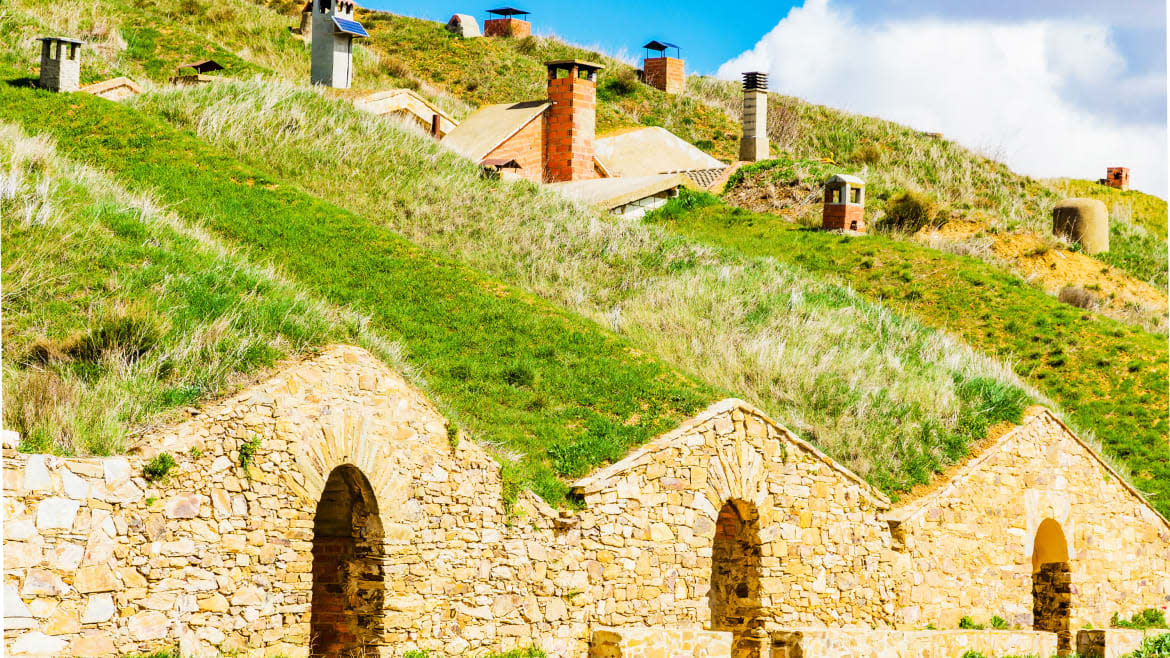
Jiménez de Jamuz is Hicksville, Spain. On the southern plains of León province, an hour from the Portuguese border and three from Madrid, this village of 800 souls has little to distinguish it from a thousand other sleepy pueblos across the length and breadth of Spain. A small river, the Jamuz, slithers along a shallow valley among plantations of poplar trees, leaving the village behind as if there were nothing to detain it here. For sure Jiménez is no great beauty, but a jumble of two-storey houses in varying states of repair and antiquity, some faced with bare brick, others with their original walls of wattle and daub gently disintegrating under the weather. A handful of bars and a couple of pottery workshops are as far as it goes in terms of a flourishing commercial sector.
Yet the signs are there, if you know how to read them. Even before you get to this one-horse town, a large billboard above the A6 highway from Madrid to La Coruña informs drivers they are just 30 minutes from a place called Bodega El Capricho, giving no more information than the mysterious tag-line “Arte en Carne” (“Art in Meat”).
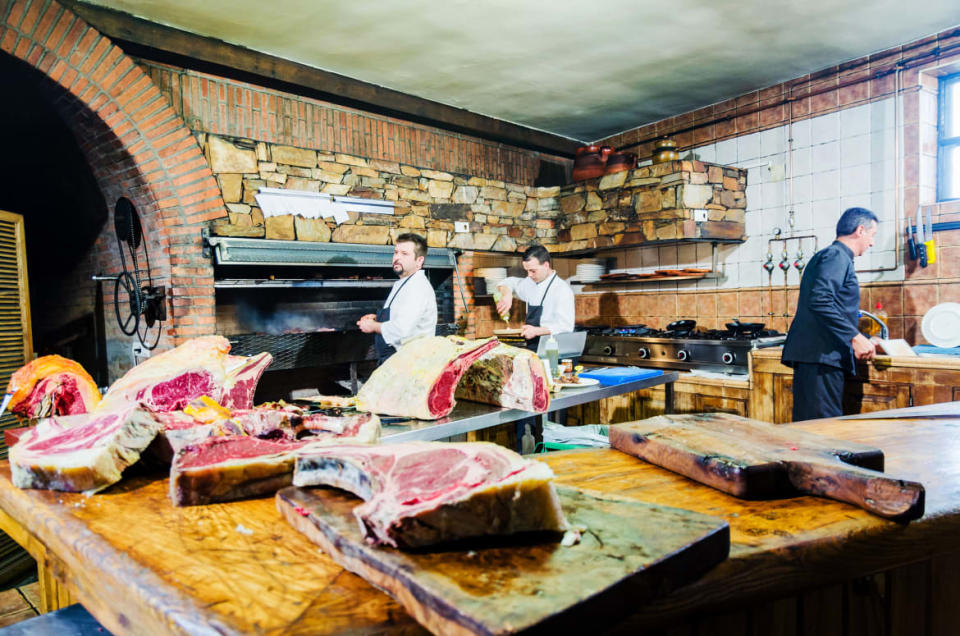
Kitchen Bodega El Capricho and its raw material in Jiménez de Jamuz, Santa Elena de Jamuz, Leon, Castilla y Leon, Spain.
If one of the meanings of “cult” is a “strong devotion or interest in a particular person, idea or thing,” El Capricho fits that definition to a T-bone. For more than two decades this grill restaurant specializing in cuts of long-lived, long-matured ox (buey in Spanish) has been maturing into a global gastronomic phenomenon. In 2007 Time magazine declared this the home of the world’s very best beef, ahead of the finest Manhattan steak-houses, Texan barbecue joints, and Japanese wagyu temples. Its fame goes before it, yet somehow El Capricho still gives off the masonic-handshake feeling that only a select group of cognoscenti, a cabal of carnivores, are in on the secret.
Browsing its Tripadvisor entry I scrolled through the welter of five-star reviews, each more breathlessly enthusiastic than the last. “Mind-blowing,” “Five stars are not enough,” and “Meat lovers should make the pilgrimage at least once in a lifetime,” were just the simpler ones. But there were also ecstatic personal testimonies—”I traveled 14,000km to eat here and the experience was sublime”—and aesthetic musings—”Only the sheer will of an individual can bridge the gap between food and art.”
My curiosity was piqued. As a fussy foodie who will eat meat only if it’s organic and high-welfare—and preferably raised on my homestead in Extremadura—I like to think my standards are high. So the question formed itself in my skeptical journalist’s brain: Could El Capricho possibly be all it was cracked up to be? For lovers of prime beef this place certainly looked like one hot destination. But, I wondered, how much about its reputation was simply hot air?
There was, as they say, only one way to find out. I booked myself a table for lunch and a room at the Hospedaje Doña Elvira in Jiménez de Jamuz. This rather sleek and chic village lodging, opened by El Capricho in July 2021, is a great way of saving yourself the drive to León or Astorga after a long meal with lashings of fine wine.
Any cult worth its salt must have a guru, and in this case it’s José Gordón. Son and grandson of small-time farmers and vineyard owners, 56-year-old Gordón presides over a meat-based empire including a livestock farm and butchery plant, a flourishing mail-order business, and an asador (grill) serving the beef from his home-reared cattle.
The restaurant stands on the outskirts of town among a curious landscape of cave-like cellars burrowed like hobbit-houses out of the hillside: the wine bodegas (240 of them in total) of Jiménez de Jamuz. When I arrive Gordón is in his white kitchen coat, busy with a side of beef that has just come in from the maturing rooms where it has spent the last three months at a constant temperature of between 32-38 °F. Possessed of a countryman’s stocky, thickset build, he is hunched over it like a sculptor over a block of stone, slicing away the massive steaks with a giant butcher’s knife.
This monumental slab of flesh and bone once belonged to a 10-year-old ox (defined as a castrated bull) that labored under the yoke on a family farm in northern Portugal. Gordón points out the mottled colors of natural molds on the thick layer of external fat and the intricate marbling within the dark purple meat, offering me a translucent slice on the side of his knife by way of welcome. It practically melts on the tongue and, despite its three-month cure, has a clean and fresh, but rich and haunting taste.
The Gordón family have always been country people but never kept cattle—in fact this part of León province is better known for lentils (those of La Bañeza are famous in Spain) than livestock. José's grandfather tended vineyards and made wine in the family bodega, which he himself carved out of the hillside with pick and shovel. It was he, Segundo Gordón, who first opened a simple merendero—no more than a picnic spot with two tables under a corrugated roof—where you could try the house wine with a tortilla de patata or a serving of cecina, the air-dried beef typical of León, in the thinnest of slices.
Meanwhile young José was busy being a bad student who preferred roaming in the countryside, fishing in the river, and hunting for birds’ nests, to applying himself to schoolwork.
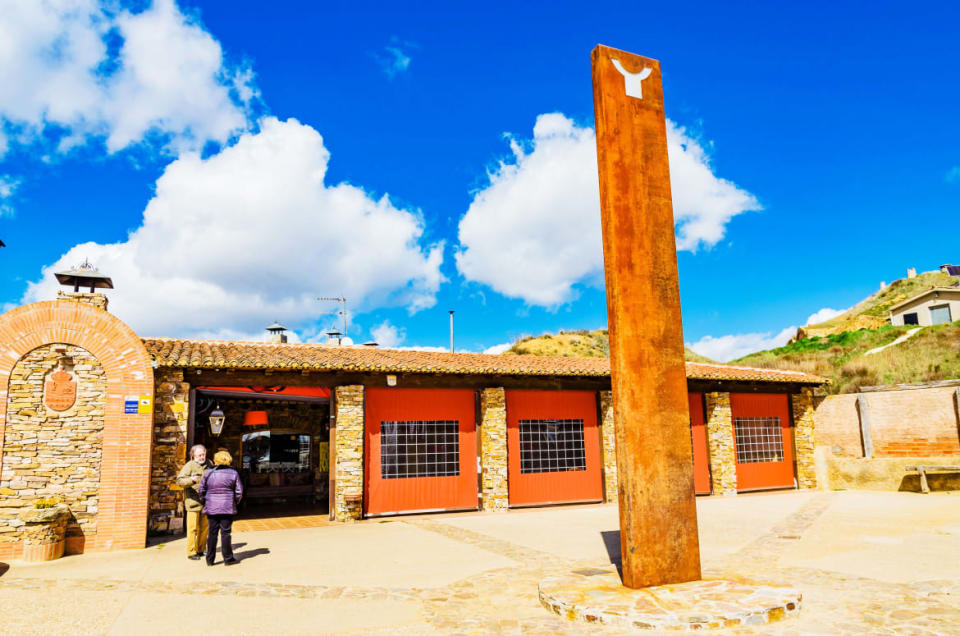
Bodega El Capricho. Jiménez de Jamuz, Santa Elena de Jamuz, Leon, Castilla y Leon, Spain.
In his late teens he began working at the merendero, which had now grown into a popular local restaurant. At the helm of an impromptu barbecue Gordón taught himself the arcane arts of grilling over coals. “By 17 I was an expert,” he tells me. “I soon understood that 30 seconds on the grill is an eternity, because in half a minute you can destroy a piece of meat.”
But the key to El Capricho's success is as much about product as technique. Gordón’s road-to-Damascus moment came in the late 1980s during a trip to Galicia, a region of northwestern Spain where pre-modern agriculture still clings tenaciously to life, when he stood in a farmyard to see an enormous ox weighing in at somewhere around 1.5 tons staring quietly back at him.
“It was an animal with an incredible nobility. It was huge, majestic, but transmitted to me such a sense of peace,” he remembers. “For the owner it was like a family member; he would cook up potatoes and turnip tops for it to eat. I finally bought that ox, though for the owner it was like selling a son. The experience opened my eyes. And ever since, for me, oxen have something magical about them.”
He promptly embarked on a series of buying trips all over the Iberian peninsula, building up connections with the few farmers still maintaining old-fashioned Spanish and Portuguese breeds such as the Tudanca, Sayaguesa, Barrosa, Minhota, and Cachena. As word got around that a man from León was prospecting for rare-breed oxen, the phone calls started coming. “And I realized that everything I'd perceived in that farmyard in Galicia had a deeper dimension: these noble, tranquil animals gave the most delicious beef you could imagine. It was all about the meat.”
His morning’s work accomplished, we climb into Gordón’s battered 4x4 and make the short drive to a 148-acre farm where a herd of around 350 oxen live luxurious lives among rolling fields and holm-oak woods. El Capricho was a farm-to-fork operation long before the term was coined.
“For me it’s important that this is a beautiful place,” he confides. “The animals have a right to fresh air, peace, and beauty. They need to see water, hear the birds singing, the sounds of nature.”
And here they all are, standing or lying in the open countryside beside a lake, placidly chewing the cud. Some of these beasts are truly colossal and have horns worthy of the mythical minotaur, yet none shows any sign of testosterone-fueled aggression. Gordón reaches through the fence to scratch between the horns of an animal the size of a rhino that has ambled slowly towards him like a pet dog.
His cellphone rings: it’s a man who’s been keeping a Limousin ox in the backyard for 10 years and now wants to sell it. José says to please send photos.
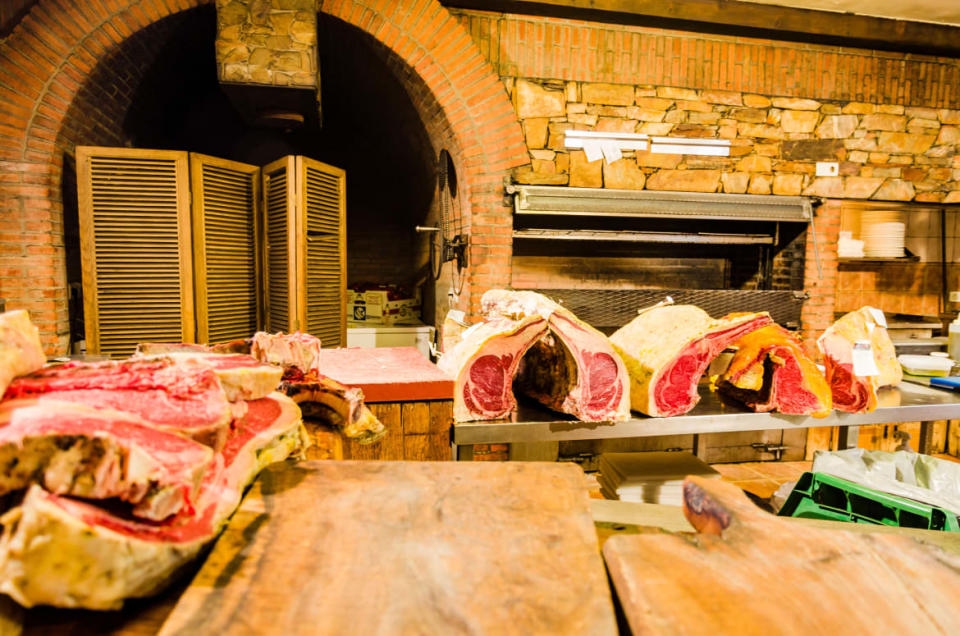
Kitchen Bodega El Capricho and its raw material. Jiménez de Jamuz, Santa Elena de Jamuz, Leon, Castilla y Leon, Spain.
A retired ox of a heritage breed can be worth up to $10,000; no wonder the guy is keen to sell. But Gordón is choosy. He likes to buy animals no younger than 4 years old and keep them for a further five to 10 (an ox can live to 20+), allowing the fat-marbled meat to develop slowly over time. He won’t countenance the use of antibiotics or other prophylactic drugs at any stage of their lives. Once here on the farm, their diet is natural pasture with a supplement of organic cereals (corn, barley, soya) sourced from local suppliers. In death, as in life, a welfare policy applies. The oxen are taken to a nearby slaughterhouse where they spend their last night calmly in the open air and are showered to relax them before what Gordón calls the “moment of plenitude.”
It's getting on for 2.30pm: a reasonable hour for the midday meal in notoriously late-dining Spain. As we drive back to the restaurant my host regales me with anecdotes of customers who made the pilgrimage from far and wide. There was one client who took a private jet all the way from Australia; another who pitched up for lunch at the restaurant, stayed for dinner, ate lunch and dinner the next day and left the following morning. It was the French-made Netflix documentary Steak (R)evolution (2014), in which Bodega El Capricho is accorded the top slot among the world's best “meateries,” that finally made this place a household name in global meat-freak circles. Since it hit the screens, Gordón is used to welcoming Japanese diners who can’t quite believe their storied cathedrals of Kobe beef have been pipped to the post by this rustic Spanish outsider. On one occasion, he recalls, a whole load of meat-industry bigwigs from Tokyo turned up en masse to see what all the fuss was about.
And now it’s my turn. Because as the old adage has it, the proof of the pudding—or the rare-breed long-aged ox steak—is in the eating.
My host leads me to my table in the dining room, which occupies the underground cellar where his father Pedro once stored his barrels of wine. It's an extraordinary space, dark and cool, its rounded organic forms sculpted out of the clay soil recalling the desert architecture of Algeria and Morocco. On the next table is a large group of Venezuelans who have converged on El Capricho from their various places of exile in Europe and America. There is no phone coverage, WiFi signal, or natural light down here, so that your attention is entirely focused on one thing. Once again, it’s all about the meat.
José suggests I try his signature Homenaje (“Homage”) menu, a 14-course feast priced at what seems like a fairly steep 180€ ($189). I scan the menu card, suddenly feeling a little queasy. Almost everything on it contains ox, naturally enough, but I worry the sheer quantity of meat I am being asked to ingest might disagree with me. I’m not at all sure I like the idea of “ox-blood pudding with brioche.” Also the “special ox dessert,” apparently made with fat from around the animal’s kidneys combined with white chocolate and coffee, sounds like a challenge I might not be equal to.
But then the food starts arriving and I stop fretting, helped in part by a big glass of the house wine, a lush velvety red made from Prieto Picudo grapes grown at Pedro Gordón’s El Chano vineyard.
Far from being overwhelming, the tasting menu is a series of simply presented and delicate bites, clearly designed to show off the excellence and versatility of the meat in question. A wafer-thin slice of slow-cooked silverside, like the best of all possible roast beef, sets the tone. Then comes a roundel of perfect rump-steak tartare with a smattering of caviar and a Peruvian-style tiradito of sirloin with wild tuna tartare—inspired surf-and-turf combinations, both. The bone-marrow on toast, its richness cut with fresh grapefruit and finely chopped jalapeño, is a dish I won’t easily forget. Neither is the home-made cecina, cured for a full three years, which comes in pellucid slices against a plain white plate and has a deep, sweet flavor that makes me think Spanish air-dried beef might just be the next ibérico ham.
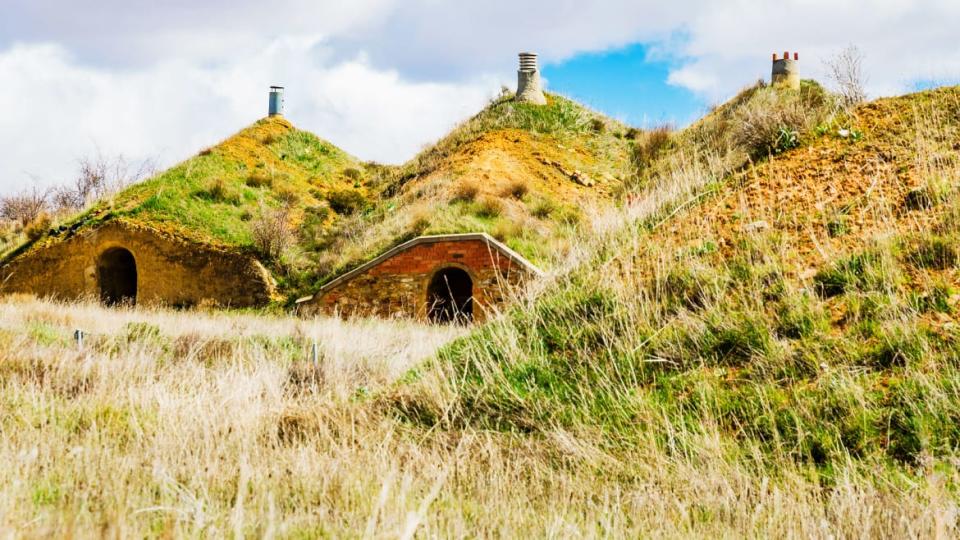
Ancient underground wineries. Traditionally, residents dig cellars to store their wines. They are located on the outskirts of the villages.
All this is, however, a mere prelude to the main attraction—a whole ox chop grilled over holm-oak wood from the farm I visited this morning. José reappears at my table in his chef whites to carve the huge chuleta in front of me, basting the slices in the fragrant oils that have seeped out over the board. The grilling procedure, I’m told, involves a “tempering” at 100F at some distance from the coals, after which the meat is brought closer to the fire to cook briefly at 120F. So there’s caramelization, but no actual burning on the surface, and therefore no crust.
When it comes to beef my lazy assumption was always that young means tender, old means tough. So this steak from a 9-year-old Minhota ox, born near the Portuguese town of Famalicao and dry-aged for no less than 160 days, makes mincemeat of my prejudices. It’s fabulously tender and toothsome, and its reverberant flavor never for a moment suggests mustiness or cheesiness—faults I’ve often encountered in long-aged beef.
I finally totter out of that meat-cave, blinking in the late-afternoon sun, feeling like some Neanderthal hunter who’s just binged on roast mammoth.
Slumped in a garden chair with a glass of herb liqueur in hand, several thoughts push their way through my digestive brain fog. One, that 180 euros is actually a fair price for a culinary experience at this stratospheric level of quality. And two, that if modern meat-eating is about less, but better, the occasional splurge at José Gordón’s place might be just the kind of thing we should all be aiming for. You might think this exaltation of red meat a vegetarian’s nightmare—but there’s a paradox in there somewhere. Strangely and wonderfully, El Capricho’s guiding principles turn out to lie closer to ethical vegetarianism than to the multinational meat industry and its monstrous cruelties, its terrifying economies of scale.
So if you ask, was it worth the journey to Jiménez de Jamuz, I’d say it was. Indeed, on the basis of this visit I’d be happy to add my own five-star rave review—”sublime!,” “exquisite!,” “best beef ever!”—to that Tripadvisor entry at a moment’s notice.
Except for one thing. Reader, I passed on the ox dessert.
Get the Daily Beast's biggest scoops and scandals delivered right to your inbox. Sign up now.
Stay informed and gain unlimited access to the Daily Beast's unmatched reporting. Subscribe now.

